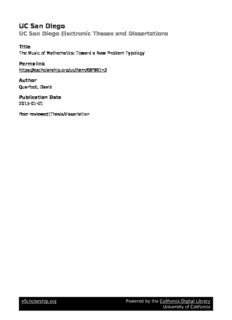
UNIVERSITY OF CALIFORNIA, SAN DIEGO SAN DIEGO STATE UNIVERSITY The Music of ... PDF
Preview UNIVERSITY OF CALIFORNIA, SAN DIEGO SAN DIEGO STATE UNIVERSITY The Music of ...
UC San Diego UC San Diego Electronic Theses and Dissertations Title The Music of Mathematics: Toward a New Problem Typology Permalink https://escholarship.org/uc/item/68f901n3 Author Quarfoot, David Publication Date 2015 Peer reviewed|Thesis/dissertation eScholarship.org Powered by the California Digital Library University of California UNIVERSITY OF CALIFORNIA, SAN DIEGO SAN DIEGO STATE UNIVERSITY The Music of Mathematics: Toward a New Problem Typology A dissertation submitted in partial satisfaction of the requirements for the degree Doctor of Philosophy in Mathematics and Science Education by David Quarfoot Committee in charge: University of California, San Diego Professor James Hollan Professor Gabriele Wienhausen San Diego State University Professor Richard Levine, Chair Professor Chris Rasmussen, Co-Chair Professor Susan Nickerson 2015 Copyright David Quarfoot, 2015 All rights reserved. SIGNATURE PAGE The Dissertation of David Quarfoot is approved, and it is acceptable in quality and form for publication on microfilm and electronically: Co-Chair Chair University of California, San Diego San Diego State University 2015 iii DEDICATION For my parents – Beth and Jim Quarfoot – whose love and example inspired me to be the man I am today. For the three Matts in my life – Matt Quarfoot, Matt Madson, and Matt Ruggirello – who, together, showed me how to live, love, and learn. And for the two who understood me at my core – my grandmother, Reva Warren, and my best friend, Marquis Tisdale. iv TABLE OF CONTENTS Signature Page ............................................................................................................................. iii Dedication ..................................................................................................................................... iv Table of Contents........................................................................................................................... v List of Abbreviations .................................................................................................................... xi List of Figures ............................................................................................................................. xii List of Tables ............................................................................................................................... xv Acknowledgements ................................................................................................................. xviii Vita ............................................................................................................................................. xix Abstract of the Dissertation ......................................................................................................... xx Chapter 1: The Problem ................................................................................................................ 1 A Thought Experiment ..................................................................................................... 1 Why Mathematical Problems? .......................................................................................... 3 Why Mathematical Problems Now? ................................................................................. 6 Overview of the Research Plan ...................................................................................... 12 Research Questions ........................................................................................................ 16 Conclusion ...................................................................................................................... 17 Chapter 2: Literature Review ..................................................................................................... 19 Overview ........................................................................................................................ 19 Mathematical Problem Solving ...................................................................................... 19 Cognition ........................................................................................................... 20 Metacognition .................................................................................................... 29 Affect, Beliefs, and Society ............................................................................... 35 Conclusion ......................................................................................................... 41 v Mathematical Problem Features ..................................................................................... 42 Cognition/Metacognition ................................................................................... 45 Affect/Beliefs/Society ....................................................................................... 62 Conclusion ......................................................................................................... 71 Typologies ...................................................................................................................... 71 Binary MPTs ..................................................................................................... 73 Multilevel MPTs ................................................................................................ 74 Two-Dimensional MPTs ................................................................................... 76 The Jonassen Typology ..................................................................................... 79 Conclusion ......................................................................................................... 82 Educational Data Mining ................................................................................................ 83 A Description of EDM ...................................................................................... 83 Organization of EDM ........................................................................................ 84 Conclusion ......................................................................................................... 87 Conclusion ...................................................................................................................... 87 Chapter 3: Methodology ............................................................................................................. 88 Thread 1: From MPFs to LAMs and PSMs ................................................................... 88 Number of Entry/Exit Points ............................................................................. 91 Number of Solutions .......................................................................................... 91 Number of Steps ................................................................................................ 92 Difficulty ........................................................................................................... 92 Presence of Misconceptions .............................................................................. 93 Resource Creation ............................................................................................. 93 Development of Metacognition ......................................................................... 94 Variety of Representational Media .................................................................... 94 vi Appropriateness ................................................................................................. 95 Internal Resource Collaboration ........................................................................ 95 Insufficient/Extraneous Information .................................................................. 96 Amount Learned ................................................................................................ 96 Cognitive Engagement ...................................................................................... 96 Novelty .............................................................................................................. 98 Cognitive Sophistication ................................................................................... 99 Creativity ........................................................................................................... 99 Elegance ............................................................................................................ 99 Productive Dispositions ................................................................................... 100 Degree of Encouragement ............................................................................... 100 Lifelong/Self-Directed Learning ..................................................................... 101 External Collaboration ..................................................................................... 101 Affective Engagement ..................................................................................... 101 Focus on Inequity ............................................................................................ 102 Authenticity ..................................................................................................... 102 Concluding Thoughts ...................................................................................... 102 Thread 2: From Data Set to LAM-Side MST .............................................................. 104 Alcumus Data Set Overview ........................................................................... 104 Munging .......................................................................................................... 111 New Columns .................................................................................................. 114 LAM Construction ........................................................................................... 121 Thread 3: Metric Creation to the Full MST ................................................................. 123 Metric Parameter Exploration ......................................................................... 124 vii The Expert Panel ............................................................................................. 127 Inter-Rater Reliability ...................................................................................... 131 Video Analysis ................................................................................................ 135 CDW/DQ Scoring ........................................................................................... 137 Thread 4: From Contexts to Correlations .................................................................... 142 Figure 3.23, Stage 1 ......................................................................................... 144 Figure 3.23, Stage 2 ......................................................................................... 146 Figure 3.23, Stage 3 ......................................................................................... 152 Conclusion .................................................................................................................... 155 Chapter 4: Contextualized Analysis ......................................................................................... 156 Continuing Thread 2: The LAM Side of the Full MST ............................................... 156 Continuing Thread 4: Analysis of the Contextualized Results .................................... 166 Appendix E Findings ....................................................................................... 170 Appendix F Findings ....................................................................................... 190 Conclusion .................................................................................................................... 202 Macro Findings ................................................................................................ 202 Micro Findings ................................................................................................ 202 Chapter 5: Decontextualized Analysis ...................................................................................... 206 Metric Analysis ............................................................................................................ 207 Predicting the PSMs from the LAMs ........................................................................... 217 New Dimensions for Mathematical Problems .............................................................. 223 Problem Analysis .......................................................................................................... 241 A New Mathematical Problem Typology ..................................................................... 247 Conclusion .................................................................................................................... 261 On Metrics ....................................................................................................... 261 viii On Problems and Typologies .......................................................................... 262 Chapter 6: Conclusion .............................................................................................................. 265 Overview of Results ..................................................................................................... 265 Implications for Teachers and Students ........................................................................ 268 Implications for Research ............................................................................................. 271 Limitations .................................................................................................................... 274 Future Directions .......................................................................................................... 276 Final Thoughts .............................................................................................................. 280 Appendices ................................................................................................................................ 282 Appendix A: Final Metric Scoring Instruments (PSMs) ............................................. 282 Metric 1: Difficulty ......................................................................................... 282 Metric 2: Elegance .......................................................................................... 283 Metric 3: Novelty ........................................................................................... 284 Metric 4: Cognitive Sophistication ................................................................. 285 Metric 5: Internal Resource Collaboration ..................................................... 286 Metric 6: Number of Steps ............................................................................. 287 Metric 7: Creativity ........................................................................................ 288 Metric 8: Representational Media .................................................................. 289 Metric 9: Resource Creation ........................................................................... 290 Metric 10: Misconceptions ............................................................................. 291 Metric 11: Number of Solutions ..................................................................... 292 Metric 12: Productive Dispositions ................................................................ 293 Metric 13: Affective Engagement .................................................................. 294 Metric 14: Authenticity .................................................................................. 295 Appendix B: Complete R Code ................................................................................... 296 ix
Description: